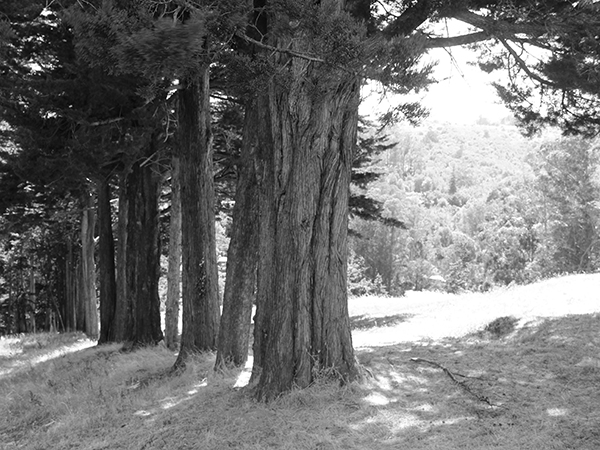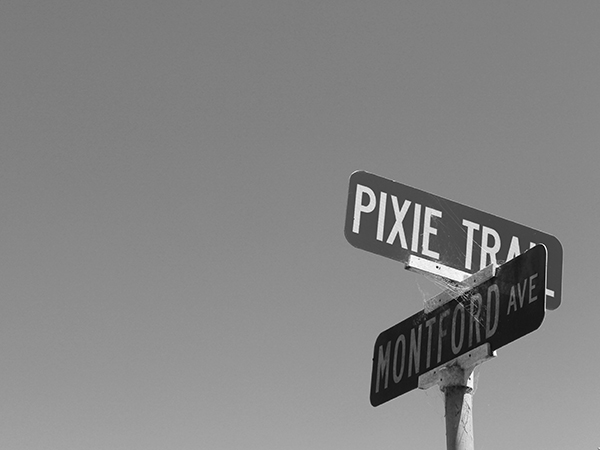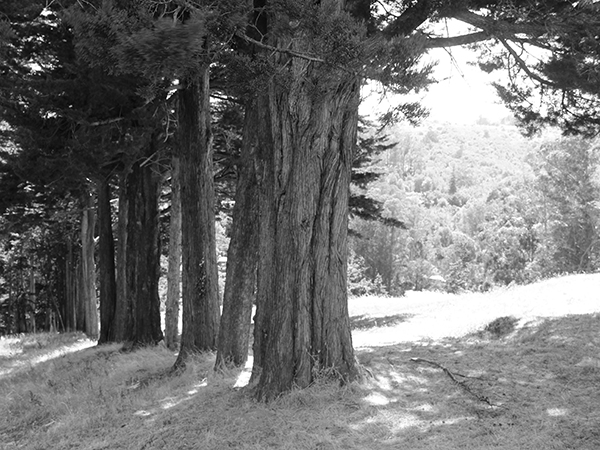“I noticed how the leaves almost looked human the way they bowed and then leaped up and then swayed lyrically side to side.” — Jack Kerouac.
 The same row of eucalyptus trees that inspired this passage of Dharma Bums stretches down from the top of Pixie Trail. Rounding the corner, the landscape opens into an expansive field of tall grass, sliced in two by a narrow path. It was at the base of this hill, hidden by the rows of branches, that the young beat writer Jack Kerouac lived for a few rent-free months in the company of Gary Snyder, a Zen poet. The house that stands there now has been rebuilt since the 1950s, but it remains relatively isolated on the hill. A goat grazes out front and a row of jugs and miscellaneous gardening tools are all that can be seen from up top. Watching the sun set over the idyllic landscape makes it easy to draw a connection between Kerouac’s words and the small pocket of Mill Valley that inspired them. It was in this house that Kerouac first began experimenting with Buddhism and from this very spot that the author departed to the fire lookout where he wrote Desolation Wilderness. Throughout the interim period, Kerouac fully integrated himself into a scene saturated with rising authors, poets and creatives. He ventured into the city to watch Allen Ginsberg’s first reading of “Howl,” served as a patron and supporter of City Lights Publishing, and partook in countless gatherings in the Mill Valley home — spontaneous events which were often attended by William S. Burroughs, Neal Cassady and Gregory Corso. It seemed that, nestled beneath Mount Tamalpais, Kerouac and his fellow writers had found a fleeting paradise.
The same row of eucalyptus trees that inspired this passage of Dharma Bums stretches down from the top of Pixie Trail. Rounding the corner, the landscape opens into an expansive field of tall grass, sliced in two by a narrow path. It was at the base of this hill, hidden by the rows of branches, that the young beat writer Jack Kerouac lived for a few rent-free months in the company of Gary Snyder, a Zen poet. The house that stands there now has been rebuilt since the 1950s, but it remains relatively isolated on the hill. A goat grazes out front and a row of jugs and miscellaneous gardening tools are all that can be seen from up top. Watching the sun set over the idyllic landscape makes it easy to draw a connection between Kerouac’s words and the small pocket of Mill Valley that inspired them. It was in this house that Kerouac first began experimenting with Buddhism and from this very spot that the author departed to the fire lookout where he wrote Desolation Wilderness. Throughout the interim period, Kerouac fully integrated himself into a scene saturated with rising authors, poets and creatives. He ventured into the city to watch Allen Ginsberg’s first reading of “Howl,” served as a patron and supporter of City Lights Publishing, and partook in countless gatherings in the Mill Valley home — spontaneous events which were often attended by William S. Burroughs, Neal Cassady and Gregory Corso. It seemed that, nestled beneath Mount Tamalpais, Kerouac and his fellow writers had found a fleeting paradise.
Snyder named the cabin “Marin-An,” according to Kerouac a Biography, a book that can be found at the Mill Valley Public Library. In the chapter dedicated to Kerouac’s brief time in Homestead Valley, the house’s interior is described in perfect detail. “Jack felt at home in Snyder’s shack halfway up the hill, where the floor was covered with straw mats, the mattress with a paisley cover and the walls lined with burlap. Gary had filled the room with bouquets of mountain flowers and pinned prints of Chinese paintings and area maps of Marin County and Northwest Washington to the walls.”
One of Snyder’s poems is also recounted:
White crowned sparrows Make tremendous singings in the trees The rooster down in the valley crows and crows Jack Kerouac outside, behind my back Reads the Diamond Sutra in the sun.
 But even among such lively company, Kerouac continued his descent into patterns of alcoholism and loneliness, eventually departing from Marin-An to embark on a 63-day stint of solitude in northeast Washington. When Kerouac reached his destination, he still had trail mix in his pack from his final ascent of Mount Tamalpais with Snyder. These are the types of details that strike me most about the writer’s time in Marin County. In this short chapter of his life, the literary giant had walked through Stolte Grove, climbed up the Dipsea Trail with Snyder and sat at the top of Pixie, admiring how the fog made the other side of the hill appear further away. He had felt a deep connection to Mill Valley and those who inhabited it, and yet, he had still left to explore the unknown.
But even among such lively company, Kerouac continued his descent into patterns of alcoholism and loneliness, eventually departing from Marin-An to embark on a 63-day stint of solitude in northeast Washington. When Kerouac reached his destination, he still had trail mix in his pack from his final ascent of Mount Tamalpais with Snyder. These are the types of details that strike me most about the writer’s time in Marin County. In this short chapter of his life, the literary giant had walked through Stolte Grove, climbed up the Dipsea Trail with Snyder and sat at the top of Pixie, admiring how the fog made the other side of the hill appear further away. He had felt a deep connection to Mill Valley and those who inhabited it, and yet, he had still left to explore the unknown.
If there was any component of Kerouac’s long and meandering life story that was constant, it was his ceaseless and insatiable desire to be something more. He did not understand the world and, more poignantly, did not understand his place in it. At 34, Kerouac came into San Francisco as a hitchhiker, spent his final dollar on the bus ride across the Golden Gate Bridge into Mill Valley and settled down as a Buddhist before leaving to adopt the lifestyle of a hermit in the wilderness. Kerouac was always shifting, but in every wanderer there is something to be said for the places they choose to linger.


